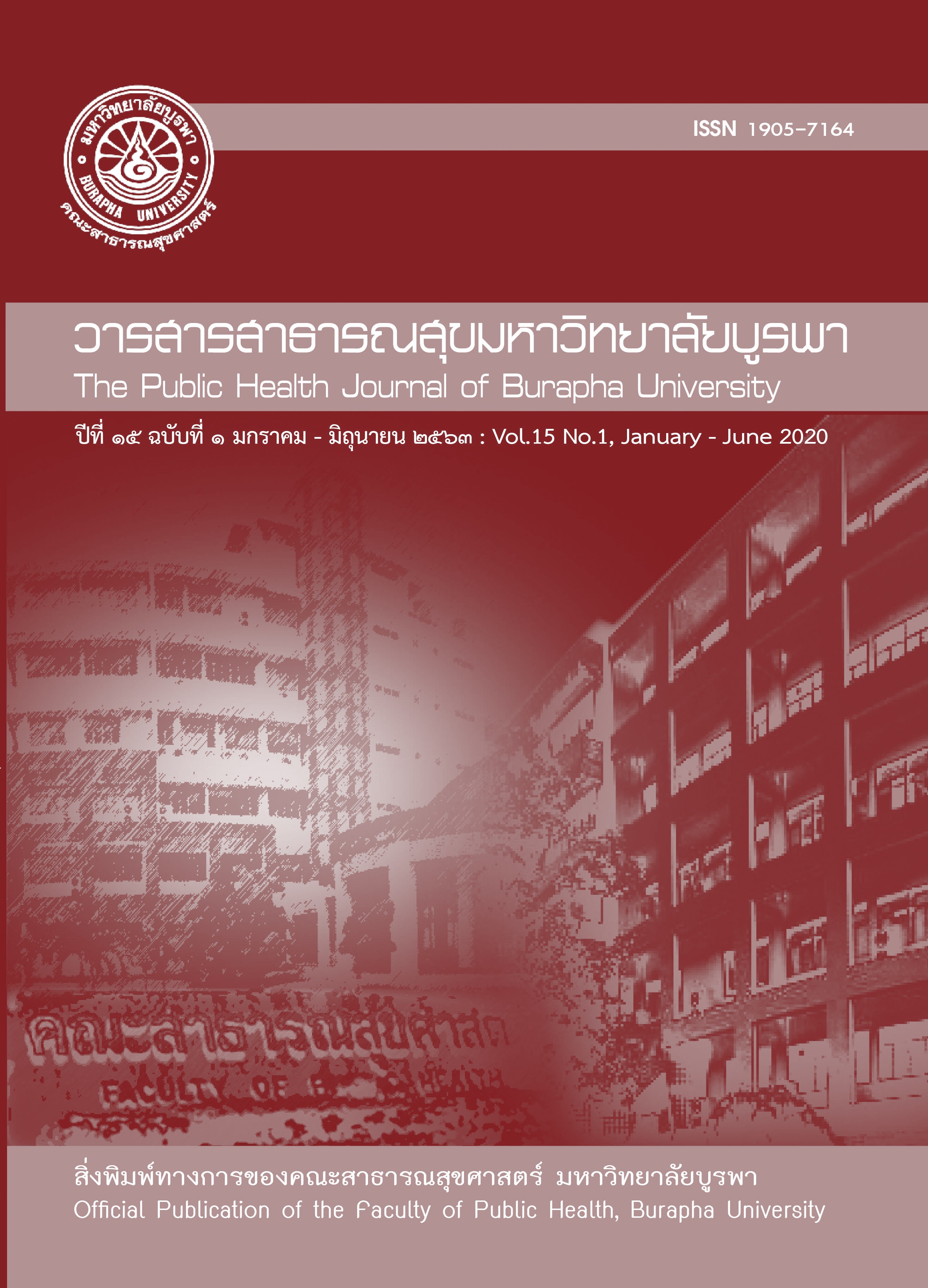การศึกษาค่าความเสี่ยงและการประเมินการรับสัมผัสสารโทลูอีนและสารเอ็มอีเคของพนักงานฝ่ายผลิตในโรงงานผลิตรองเท้ายางแห่งหนึ่งของเขตกรุงเทพมหานคร
Main Article Content
บทคัดย่อ
The study hazard quotient and evaluation of toluene and methyl ethyl ketone exposure among workers in a rubber shoes manufacturing factory in Bangkok
งานวิจัยนี้เป็นการศึกษาแบบภาคตัดขวาง โดยมีการประเมินการรับสัมผัสสารโทลูอีนและสาร เอ็มอีเคและการประเมินค่าความเสี่ยงของพนักงานฝ่ายผลิตในโรงงานผลิตรองเท้ายางแห่งหนึ่งในเขตจังหวัดกรุงเทพมหานครโดยกลุ่มตัวอย่างมี 170 คน อายุเฉลี่ย 33.32 ปี และมีสภาพการทำงานในแต่ละวันในหน้าที่หลักในการผลิตรองเท้ายาง 12 ชั่วโมงต่อวัน (รวมการทำงานล่วงเวลา) ร้อยละ 30.0 และทำงาน 6 วันต่อสัปดาห์ ร้อยละ 100.0 มีการใช้อุปกรณ์ป้องกันระบบทางเดินหายใจทุกครั้ง ร้อยละ 63.5 โดยส่วนใหญ่มีการใช้หน้ากากที่ทำมาจากระดาษกรอง ร้อยละ 96.9 ในการเก็บตัวอย่างอากาศใช้ Organic Vapor Monitor (3M 3500) ติดตัวบุคคลในระดับการหายใจของกลุ่มตัวอย่าง พบว่า กลุ่มตัวอย่าง (n=100) มีค่าเฉลี่ย ± ส่วนเบี่ยงเบนมาตรฐานของสารโทลูอีน 19,780.94± 46,529.281 ppb และสารเอ็มอีเค 22,173.79± 29,356.401 ppb และมีการเก็บตัวอย่างปัสสาวะหลังสิ้นสุดการงาน พบว่า กลุ่มตัวอย่าง (n=170) มีค่าเฉลี่ย ± ส่วนเบี่ยงเบนมาตรฐานของสารโทลูอีนในปัสสาวะ 0.146 ± 0.200 mg/l และสารเอ็มอีเคในปัสสาวะ 0.282 ± 0.397 mg/l และเมื่อประเมินค่าความเสี่ยง พบว่า สารโทลูอีนและสารเอ็มอีเค อยู่ในระดับอันตรายมากและเมื่อหาความสัมพันธ์ระหว่างปริมาณระดับความเข้มข้นของสารเอ็มอีเคในบรรยากาศการทำงานแบบติดตัวบุคคล มีความสัมพันธ์กับปริมาณระดับความเข้มข้นของสารเอ็มอีเคในปัสสาวะอย่างมีนัยสำคัญทางสถิติที่ระดับ 0.01 (p<0.001) จากผลการศึกษาครั้งนี้ทำให้ตระหนักได้ว่า กลุ่มตัวอย่างมีการสัมผัสสารโทลูอีนและสารเอ็มอีเคในขณะที่ปฏิบัติงานและควรให้ความสำคัญการส่งเสริมสุขภาพรวมถึงการให้ความรู้เกี่ยวกับการใช้อุปกรณ์ป้องกันระบบทางเดินหายใจที่ถูกต้องและเหมาะสมตลอดระยะเวลาการปฏิบัติงาน
This research was a cross sectional study. The objectives were to evaluate toluene and methyl ethyl ketone (MEK) exposure, hazard quotient among workers in a rubber shoes manufacturing factory in Bangkok. We sampled 170 persons. Mean age of the cases was 33.32 years old. Thirty percent of the cases worked 12 hours per day (including over time), 6 days per week (100.0%). Sixty three point five percent always used respiratory protection; however, most of them used only paper filter masks (96.9%). Collection of personal organic solvent exposure was conducted using “Organic Vapor Monitor (3M 3500)”, attached to the lapel of each of the cases (n=100). Results of the study group showed an average toluene concentration 19,780.94± 46,529.281 ppb and MEK 22,173.79± 29,356.401 ppb. Urine samples were collected at the end of work shift. Results of urine samples (n=170) showed an average of toluene in urine of 0.146 ± 0.200 mg/l and MEK in urine 0.282 ± 0.397 mg/l. Hazard quotient (HQ) showed that toluene and MEK was high level. However, the relationship between MEK in atmosphere and and MEK in urine of the study group was significantly groups at 0.01 significant level (p<0.001). Based on the results of this study, toluene and MEK exposure among the workers was detected. Health promotion should be emphasized. Respiration protective equipment should also be provided.
Article Details
เอกสารอ้างอิง
Textbook of Occupational Medicine First edition. กรุงเทพฯ: โรงพยาบาลนพรัตนราชธานี กรมการแพทย์ กระทรวงสาธารณสุข. 2554.
2. Dennison JE, Bigelow PL, Mumtaz MM, Anderson ME, Dobrev ID, Yang RS. Evaluation of
potential toxicity from co-exposure to three CNS depressants (toluene, ethylbenzene and xylene) under resting and working conditions using PBPK. J Occup Environ Hyg 2005; 2(3): 127-35.
3. Chang FK, Chen ML, Cheng SF, Shih TS, Mao IF. Dermal Absorption of Solvents as a Major
Source of Exposure Among Shipyard Spray Painters. J Occup Environ Med 2007; 49: 430-6.
4. ศรีรัตน์ ล้อมพงศ์. การประเมินผลกระทบต่อสุขภาพจากการสัมผัสสาร Organic solvent ในกลุ่ม
ปฏิบัติงานกับรถโดยสารธรรมดาในเขตกรุงเทพมหานคร. คณะสาธารณสุขศาสตร์ มหาวิทยาลัยบูรพา. 2554.
5. Jimenez-Garza, Marquez-Gamino, et.al. CYP2E1 phenotype in Mexican workers occupationally
exposed to low levels of toluene. Toxicol Lett 2012; 210 (2): 254-63.
6. Ongwandee M, Chavalparit O. Commuter exposure to BTEX in public transportation modes in Bangkok, Thailand. J Environ Sci (China) 2010; 22 (3): 397-404.
7. บุญธรรม กิจปรีดาบริสุทธิ์. ระเบียบวิธีการวิจัยทางสังคม. พิมพ์ครั้งที่ 10. กรุงเทพมหานคร: จามจุรีโปรดักส์. 2551.
8. Lemly AD. Evaluation of hazard quotient method for risk assessment of selenium. Ecotoxicol Environ
Saf 1996; 35(2): 156-162.
9. US EPA, IRIS. https://cfpub.epa.gov/ncea/iris/search/index.cfm. สืบค้นเมื่อวันที่ 9 สิงหาคม 2562.
10. ACGIH. Threshold limit values for the Chemical substances and physical agents and biological
exposure indices. American Conference of Governmental Industrial Hygienists, Cincinnati, Ohio, USA. 2012.
11. Todd L, Puangthongthub ST, Mottus K, Mihlan G, Wing S. Health survey of workers exposed to
mixed solvent and ergonomic hazards in footwear and equipment factory workers in Thailand. Ann Occup Hyg. 2008; 52 (3): 195-205.
12. Todd LA, Mottus K, Mihlan GJ. A survey of airborne and skin exposure to chemicals in footwear and equipment factories in Thailand. J Occup Environ Hyg 2008; 5 (3): 169-181.
13. Lee SC, Chiu MY, Ho KF, Zou SC ,Wang X. Volatile organic compounds (VOCs) in urban atmosphere of Hong Kong. Chemosphere. 2002; 48(3): 375-82.
14. Lee JW, Jo WK. Actual commuter exposure to methyl-tertiary butyl ether, benzene and toluene while travelling in Korean urban. Sci Total Environ. 2002; 291 (1-3): 219-28.
15. Mandiracioglu A, Akgur S, Kocabiyik N, Sener U. Evaluation of neuropsychological symptoms and exposure to benzene, toluene and xylene among two different furniture worker groups in lzmir. Toxico Ind Health. 2011; 27 (9):802-9.
16. Chen ML, Chen SH, Guo BR, Mao IF. Relationship between environmental exposure to toluene, xylene and ethylbenzene and the expired breath concentrations for gasoline service workers. J Environ Monit. 2002; 4(4): 562-6.

